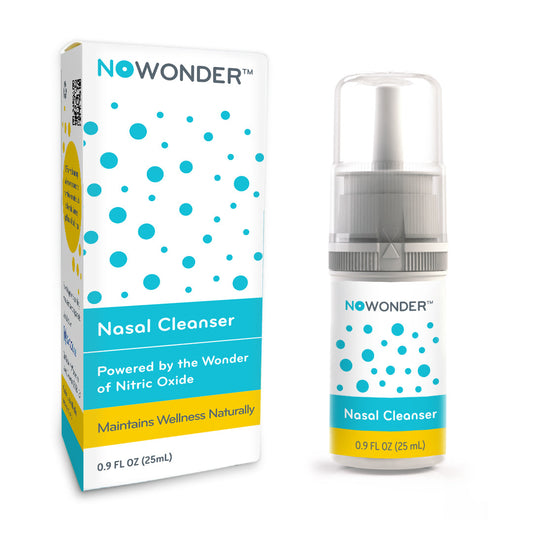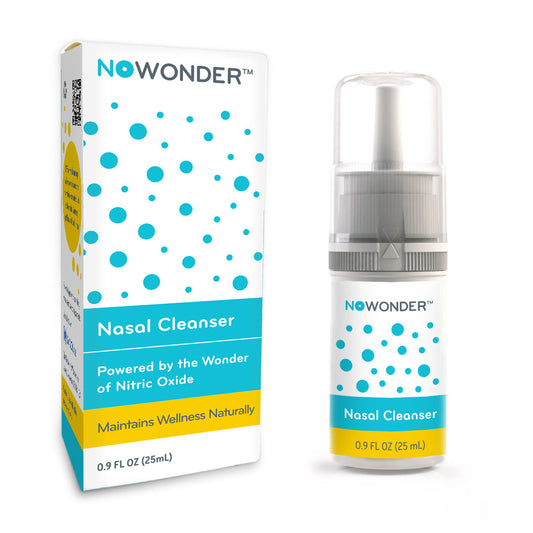SaNOtize NONS is a nitric oxide nasal spray that releases a small dose of nitric oxide and is designed to kill viruses in the upper airways.
SaNOtize nasal spray prevents viruses from incubating and spreading to the lungs by providing a physical and chemical barrier.
It doesn’t just block viruses but actually kills them.
Watch this video to learn about the mechanism of action:
What is Nitrc Oxide: Nitric oxide (NO) is a well-understood, well-studied nano-molecule that naturally occurs in the body. It has several physiologic functions, including dilating blood vessels and helping regulate the body's immune response to infection. Its first therapeutic approval, in 1999, leveraged its selective vasodilatory effects for the hospital treatment of blue baby syndrome (persistent pulmonary hypertension of the newborn). Moreover, for decades, NO has also been studied for its potentially robust antimicrobial properties across a wide range of pathogens. Our studies show that when NO is delivered to a site of infection in the right dose (e.g. concentration and duration), it kills the pathogen, but is safe for the human cells.
How it kills pathogens: Nitric oxide (NO) has multiple mechanisms of action (MOA) as an antimicrobial. As an antiviral, NO can prevent viruses from entering cells and replicating. NO rapidly inactivates the virus via conformational changes to the spike proteins and proteases, which lead to a fast reduction in viral load. The molecule also has several MOA in single-celled organisms (bacteria and fungi), including DNA damage and inhibition of DNA repair, as well as lipid damage via lipid peroxidation, among others. These mechanisms make NO an effective antimicrobial, able to stand up to evolving variants, and unlikely to lead to antimicrobial resistance. Importantly, NO can damage microbes at a dose that is safe for human cells.
Nitric Oxide is known for its antimicrobial qualities and SaNOtize's product has a practical way to deliver it as a liquid, while Nitric Oxide is formed only upon administration when all liquid ingredients are mixed.
Effected Viruses
Enovid has been shown to be effective in the lab against a wide range of viruses and new variants of the SARS-CoV-2 won’t interfere with its effectiveness. SaNOtize says “It contains a broad-spectrum antiviral which kills all viruses and all variants.” [published in The Times of Israel, 22/03/21]
Mechanism of Action
The ENOVID® Nasal Spray Device provides a mechanical and chemical barrier within the nasal cavity to protect against viruses.
Mechanical Barrier
The HPMC creates a mechanical barrier that traps viruses within the nasal cavity and prevents them from further entry into the respiratory tract causing infection.
Chemical Barrier
Citric acid provides a chemical barrier, which effectively destroys the viruses in the nasal cavity. The first chemical barrier is established by citric acid, which lowers the pH in the nasal cavity and creates a hostile environment for the virions. The second chemical barrier is formed by nitric oxide which enhances the hostile environment as further explained below.
Whether the virus enters the nose, the ENOVID® Nasal Spray Device provides a physical barrier by laying down the HPMC layer which traps virions. The environment within this gel barrier contains nitric oxide which is viricidal and inactivates the virions within the gel. This additional hostile chemical layer is due to a low pH but mainly to the short burst of nitric oxide (NO) production. During this time, NO rapidly destroys the shape of the spikes/protrusions of any virions present, through a process called nitrosylation. This process causes conformational changes that render the key-like viral spike portion required to enter the cell uselessly. The unique mechanism of action of the ENOVID® Nasal Spray Device is that the NO molecule neutralizes the virions, thus blocking their ability to connect with the ACE-2 receptors and preventing the virion from fusing to the host cell. This is important because even though NO is produced for a short period of time, its effects have long-lasting protection against viral entry that prevents infection of the host cell.
It is these mechanisms of action that contribute to the significant effect of the ENOVID® Nasal Spray Device that can reduce the chance of infection by eradicating viruses before they can infect cells, including preventing COVID-19 infection and transmission. In summary, the mechanism of action of the ENOVID® Nasal Spray Device is based on inactivating the virion itself and not by means of a pharmacological, immunological, or metabolic reaction with the body.
This mechanism of action is further supported by Racchi et al1 in the Expert Review of Medical De-vices Journal, section 4.2.3 of the article states the following:
"The mechanism of action toward pathogens is a good example to distinguish between a pharmacological and a chemical/physical mode of action. In some cases, the medical device has intended purposes that include interference with the activity of a pathogen on or within the human body. It is clear that the activity of a substance that specifically interferes with biochemical pathways of the microorganism so that its replication and/or viability are impaired constitutes a pharmacological mechanism as carried out by antibiotics of all types. On the other hand, changing the environmental conditions (osmolarity, pH, surfactants, chelators, and shields of the adhering surfaces) constitutes a physical or chemicophysical mechanism of action. An example of such action is that of cranberry extracts whose mechanism is related to interference with surface adhesion molecules of the bacteria inducing conformational changes and therefore, not allowing the formation and development of a proper biofilm and resulting (therapeutic effect) in reduced colonization by the bacteria."
The described mechanism of action in the article is exactly as described above, in which the changing environmental conditions caused by the low pH of the nitric oxide induce conformational changes in the virion pathogen, resulting (therapeutic effect) in the prevention of the virion from fusing to the host cell and causing infection.
Furthermore, the ENOVID® Nasal Spray Device is not intended to enter the body but to act in the space above or on the surfaces of the nasal epithelial cells. The absence of medicinal activity of ENOVID® inside the cell has been corroborated in animal and human trials that showed that the ENOVID® Nasal Spray Device, delivered at a high dose concentration of 500X, resulted in no detectable systemic levels of methemoglobin, the primary metabolite of nitric oxide (NO), the main component produced by the ENOVID® Nasal Spray Device.
In respiratory infection, the viruses are at their highest level within the first few days of symptoms. Specifically, this was observed in the randomized, double-blinded, placebo-controlled ENOVID® Na-sal Spray Device study conducted in the UK study, where the reported initial viral levels were greater than a million copies/mL. Despite these very high levels, the ENOVID® Nasal Spray Device significantly and rapidly reduced viral load within 24-74 hours. This means that the ENOVID® Nasal Spray Device would easily eradicate lower numbers of viruses during brief exposures to an infected person. It takes many hours for the virus to infect the host cells, then replicate and spread to other cells before the numbers of viruses reach the levels as measured in the ENOVID® Nasal Spray De-vice study. It is easy to conclude that using the ENOVID® Nasal Spray Device during the initial entry of the virus into the nasal cavity would prevent infection in the exposed individual and also reduce the number of viruses that might infect others.
In summary, the ENOVID® Nasal Spray Device creates a mechanical barrier with the HPMC and a chemical barrier that prevents viral activity due to low pH (created by the citric acid) and exogenous destruction of viruses (by the nitric oxide) within the nasal cavity.
*Taken from "Confirmation Device Classification SANOTIZE ENOVID NASAL SPRAY DEVICE" document prepared by mdi EUROPA, July 2021, for SaNOtize.














